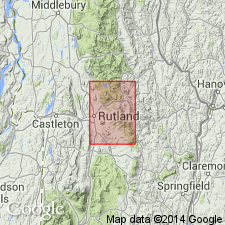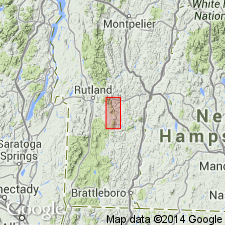
- Usage in publication:
-
- Saltash formation
- Modifications:
-
- Named
- Dominant lithology:
-
- Phyllite
- Quartzite
- Schist
- AAPG geologic province:
-
- New England province
Summary:
Named the Saltash formation for Saltash Mountain, VT. Consists of grits, phyllite, and quartzite that is divisible into three informal members. The lowest, member A, contains green or white grits, schist and sericite quartzite, and a few conglomerate beds. Member B is graphitic black phyllite with thin dolomite and limestone beds. Member C consists of vitreous quartzites; a few beds of dolomite and thin-bedded graphitic quartzite separate it from member B. The thickness of the Saltash varies from 1700 to 2000 feet. Unit unconformably overlies the Mount Holly complex and unconformably underlies the Tyson formation. Unit is of Precambrian(?) age.
Source: GNU records (USGS DDS-6; Reston GNULEX).

- Usage in publication:
-
- Saltash Formation
- Modifications:
-
- Not used
- AAPG geologic province:
-
- New England province
Summary:
The Saltash Formation of Brace (1953) is not considered a separate stratigraphic unit. Author states that the informal unit A of the Saltash Formation is actually retrograded salt-and pepper-textured actinolite gneiss and associated calc-silicate gneiss of the Mount Holly Complex. Units B and C of the Saltash are metasedimentary rocks belonging to the Tyson Formation.
Source: GNU records (USGS DDS-6; Reston GNULEX).
For more information, please contact Nancy Stamm, Geologic Names Committee Secretary.
Asterisk (*) indicates published by U.S. Geological Survey authors.
"No current usage" (†) implies that a name has been abandoned or has fallen into disuse. Former usage and, if known, replacement name given in parentheses ( ).
Slash (/) indicates name conflicts with nomenclatural guidelines (CSN, 1933; ACSN, 1961, 1970; NACSN, 1983, 2005, 2021). May be explained within brackets ([ ]).

